Thursday 9 November 2016
White: K. Nevols (134) - Black: B. Beavis (148)
A rematch - our last encounter had resulted in a massive defeat (Game 18) and so I resolved to play calmly and solid. This time I had the white pieces.
1. e4 e6
2. Qe2
This is an off-beat response to the French. It is completely harmless for Black but avoids all the multitude of French variations. The idea is that if Black now plays 2. ... d5, as French Defence players usually do, then after 3. exd5 Black has to retake with the queen instead of the usual e-pawn.
Some games with this line move into a closed Sicilian and this is what happens here.
2. ... c5
3. Nc3 d6
4. Nf3 Nc6
5. d3 Nf6
6. g3
Black could now consider lines involving 6. .. e5 7. Bg2 Bg4 8. h3 Nd4 9. Qd1 or 7. ... Nd4 but I think White is safe.
6. ..... Be7
7. Bg2 O-O
8. O-O Qc7
So far so good. Development continuing easily. I now had to consider where to put the queen's bishop. I figured that Black might be aiming to play d5 to open some lines for the bishops. I thought of 9. Be3 but after 9. ... Ng4 could not decide between 10. Bd2 or 10. Bf4.
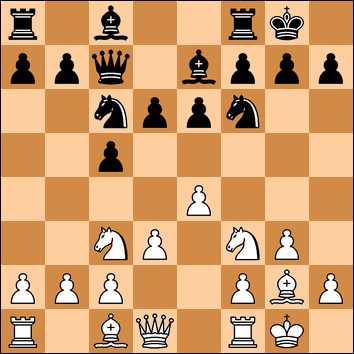
Instead I decided to provoke Black to play e5 so I would not have to worry about a d5 break and then see if I could play on the kingside as well as considering the option of Bxf6 Bxf6; Nd5.
9. Bf4 e5
10. Bg5 Be6
OK, that's the end of any Nd5 ideas. Now I wanted to get the pawn to the f4 square to add pressure on the centre and start a kingside advance - so where should I put my knight? The d2 square gets in the way of the queen and bishop while on h4 there is the possibility of hopping into f5 - so over it went.
Playing the white knight to h4 is often dubious - and I think it is here.
The computer prefers 11. Qd2 to pre-empt Black's Nd4 move. It also considers 11. a4 and 11. Bxf6 as worthy of consideration.
11. Nh4?!
The time control was 35 moves in 75 minutes each and then 15 more minutes for the rest of the game. At this stage I had 52 minutes left for 24 moves while my opponent had 59.
11. ... Nd4
12. Qd2 h6
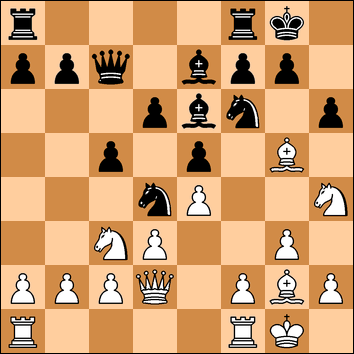
Now here I had an almighty think - and began getting into time trouble. I could not decide between Bxf6 or Be3.
If 13. Bxf6 Bxf6 14. Nf3 then Black has 14. .. Qa5 with some pressure after 15. Nxd4 cxd4 16. Nb1 Qxd2 17. Nxd2 Rfc8 or 14. ... Nxf3 15. Bxf3 Bg5. And if 13. Bxf6 Bxf6 14. Ne2 then 14. .. Bg5 is good for Black.
But the variation I considered was 13. Bxf6 Bxf6 14. Nd5 with either 14. ... Qd8 15. Nxf6 Qxf6 16. c3 or 14. ... Bxd5 15. exd5 which after 15. .. Bg5 16. Qd1 Bxh4 and Qe7 looks ugly.
Then I had a look at 13. Be3 and how could I play against 13. .. Ng4.
On principle I decided to keep the bishops on - which rather made the whole exercise a waste of time and effort.
13. Be3
Now Black could consider 13. ... g5 14. Nf3 Bg4 with pressure. (15. Bxd4 cxd4 16. Nd5 Nxd5 17. exd5 Rac8).
13. .... Ng4
14. Nf3
I now had 25 minutes left for 21 moves. The time limit was the usual 35 moves in 75 minutes and then 15 minutes for the rest of the game.
14. .... Nxe3
15. fxe3 Nc6
I think 15. ... Nxf3 16. Bxf3 would have been fine for White, easing some of the pressure - although I would keep an eye on any Bg5 ideas. Some plans based around d4 would have been considered.
With the knight's retreat, I breathed a sigh of relief and now saw I could get some initiative in the centre.
16. Nd5 Qd7
If 16. ... Bxd5 17. exd5 Nb4 then 18. e4 secures the centre and gives me time for ideas around c3 and d4 with perhaps Rac1 in there somewhere.
17. Nxe7+ Nxe7
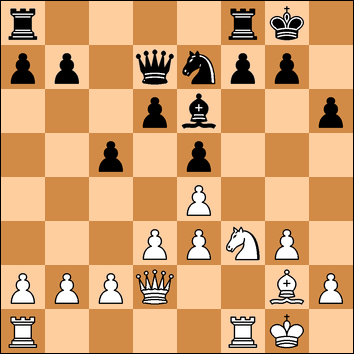
Now 18. b4!? is interesting - exploiting the decision to retake on e7 with the knight. If 18. .. cxb4 19. Qxb4 Rfc8 20. c4, or 19. .... Nc6 20. Qb5 and White is having fun again.
Black is better at the moment due to his better placed pieces. White's bishop on g2 is miserable and Black could think about ideas of a pawn break with either d5 or f5.
I gave thought here to 18. Nh4 hoping to provoke 18. .. Ng6 when I could play 19. Nf5. However, 18. .. g5 is simple enough.
Instead I decided to try to open the centre to give some space to my pieces.
18. d4! Bc4
I was not displeased to see this, as it forces me to free the f1 square where I might be able to move the bishop and either swap or gain some activity.
An interesting exchange sacrifice would be 19. dxc5!? Bxf1 20. Rxf1. White would get two pawns for the exchange. There are some good variations here - but nothing conclusive - and, being very short of time, I would not have gone for it even if I had seen it.
19. Rf2 Qc7?
A mistake from Black - 19. ... exd4 would have been better. Now White should have played 20. dxe5 dxe5 21. Qc3 winning a pawn.
20. b3?
..... But I did not see it and just wanted the bishop out of there.
20. .... Be6
21. Qc3 exd4
22. exd4 Rac8
23. Rd1
Planning to meet 23. cxd4 with 24. Qxd4 and Black has a weak pawn on d6. Now I had 12 minutes left for 12 moves.
23. ... c4
24. Qe3
An idea is 24. d5 but I do not want to open the black squared diagonal towards my king.
24. ... Qb6
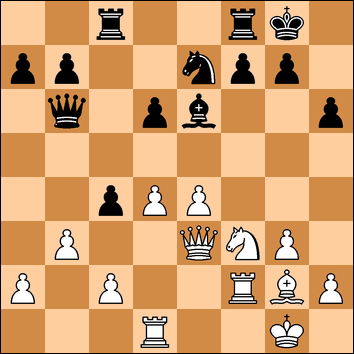
25. Nd2
Seven minutes left for ten moves.
25. ...... cxb3
26. cxb3
I was worried about 26. .. Rc2 but then 27. Nc4 wins the exchange.
26. ... Bg4
27. Bf3 Bxf3
My white bishop, which had done nothing all game, is exchanged for his very busy and active bishop. That was a very good bargain.
28. Nxf3 Qb4
I began to feel more comfortable and my only worry was the clock. If I could make the time control without blundering, I thought I could keep a drawn position.
29. Rc1 Rc6
30. Rxc6
Forced. I could not wait for the other rook to come to c8. Three minutes left for five moves.
30. .... bxc6
Probably better than 30. ... Nxc6 31. d5.
31. Rc2 Qb6
32. Qc3 Rc8
With just under two minutes to go, my priority was to get to move 35.
33. Qd3 Ng6
34. Kg2
So as not to worry about plans about Ne5 exploiting the diagonal pin to the king.
34. .... Qa5
35. Qd2 Qb6
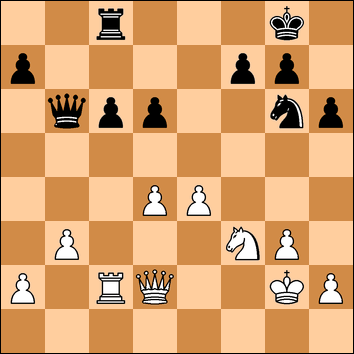
Made it! As Black moved the queen back to b6, he offered the draw to which I accepted.
On the face of it, not a very exciting game where both sides played very carefully and solidly - but Black had the edge throughout in activity although nothing conclusive.
In the final position, White might have a slight advantage and could play 36. Rc4 next but after a tiring game, I was happy to accept a draw with a higher graded player who had comprehensively beaten me last time.
Maidstone v Swale
Barrington Beavis (148) 1/2-1/2 Keith Nevols (134)
Peter Dirmauskas (99) 1-0 Tyrone Jefferies (116)
Nigel Osina (98) 1/2-1/2 Andrew Gillard (113)
Rebecca Rutter 0-1 Anthony Fletcher (74)
Maidstone 2-2 Swale
No comments:
Post a Comment